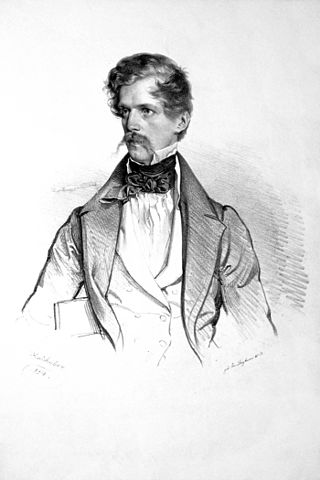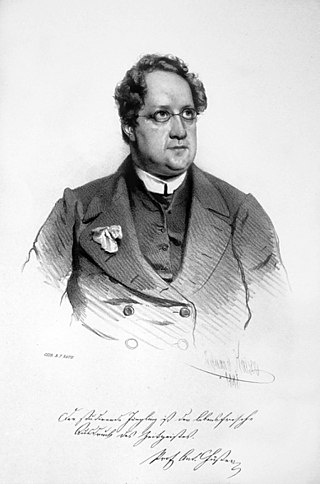
The Revolutions of 1848 in the Austrian Empire were a set of revolutions that took place in the Austrian Empire from March 1848 to November 1849. Much of the revolutionary activity had a nationalist character: the Empire, ruled from Vienna, included ethnic Germans, Hungarians, Poles, Bohemians (Czechs), Ruthenians (Ukrainians), Slovenes, Slovaks, Romanians, Croats, Italians, and Serbs; all of whom attempted in the course of the revolution to either achieve autonomy, independence, or even hegemony over other nationalities. The nationalist picture was further complicated by the simultaneous events in the German states, which moved toward greater German national unity.

The Imperial Council was the legislature of the Austrian Empire from 1861 until 1918. It was a bicameral body: the upper house was the House of Lords, and the lower house was the House of Deputies. To become law, bills had to be passed by both houses, signed by the government minister responsible, and then granted royal assent by the Emperor. After having been passed, laws were published in the Reichsgesetzblatt. In addition to the Imperial Council, the fifteen individual crown lands of Cisleithania had their own diets.

František Palacký was a Czech historian and politician, the most influential person of the Czech National Revival, called "Father of the Nation".

Anton Ritter von Schmerling was an Austrian statesman.

The Federal Constitution of Austria is the body of all constitutional law of the Republic of Austria on the federal level. It is split up over many different acts. Its centerpiece is the Federal Constitutional Law (Bundes-Verfassungsgesetz) (B-VG), which includes the most important federal constitutional provisions.
The 1848–49 United States House of Representatives elections were held on various dates in various states between August 1848 and November 1849. Each state set its own date for its elections to the House of Representatives before the first session of the 31st United States Congress convened on December 3, 1849. The new state of Wisconsin elected its first representatives, and California also held its first congressional elections before officially achieving statehood in 1850, increasing the size of the House to 233 seats.

Felix Ludwig Johann Friedrich, Prince of Schwarzenberg was a Bohemian nobleman and an Austrian statesman who restored the Austrian Empire as a European great power following the Revolutions of 1848. He served as Minister-President of the Austrian Empire and Foreign Minister of the Austrian Empire from 1848 to 1852.

The Young Czech Party was formed in the Bohemian crown land of Austria-Hungary in 1874. It initiated the democratization of Czech political parties and led to the establishment of the political base of Czechoslovakia.

The Hungarian Revolution of 1848, also known in Hungary as Hungarian Revolution and War of Independence of 1848–1849 was one of many European Revolutions of 1848 and was closely linked to other revolutions of 1848 in the Habsburg areas. Although the revolution failed, it is one of the most significant events in Hungary's modern history, forming the cornerstone of modern Hungarian national identity—the anniversary of the Revolution's outbreak, 15 March, is one of Hungary's three national holidays.

Baron Anton von Doblhoff-Dier was an Austrian statesman.

Anton Füster, also spelled as Fister was an Austrian Roman Catholic priest, theologian, pedagogue, radical political activist and author of Slovene origin. He was one of the leaders of the Viennese March Revolution of 1848.
The Pillersdorf Constitution was a constitution of the Austrian Empire that was promulgated by Minister of the Interior Baron Pillersdorf on 25 April 1848. It called for public, oral, and jury trials.
The Kremsier Constitution. also called Kremsier Draft, was a draft constitution of the Austrian Empire drafted by the Kremsier Parliament from October 1848 to early March 1849. The Kremsier Parliament had moved from Vienna to Kremsier after the failed Vienna Uprising. It was preempted by the imposed March Constitution within days of its publication.
The March Constitution, also called Imposed March Constitution or Stadion Constitution, was a constitution of the Austrian Empire promulgated by Minister of the Interior Count Stadion between 4 March and 7 March 1849. Though declared irrevocable, it was eventually revoked by the New Year's Eve Patent of Emperor Franz Joseph I on 31 December 1851. The Stadion Constitution emphasized power for the monarch; it also marked the way of the neo-absolutism in the Habsburg ruled territories. It preempted the Kremsier Constitution of the Kremsier Parliament. This state of affairs would last until the October Diploma of 20 October 1860 and the later February Patent of 26 February 1861.
The Reichstag, also called Kremsier Parliament, was the first elected parliament in the Austrian Empire. It lasted for only a short time between July 1848 and 7 March 1849, but had an important effect on Austrian history. Its main product was the Kremsier Constitution which was preempted by the imposed March Constitution.

The Margraviate of Moravia was one of the Lands of the Bohemian Crown within the Holy Roman Empire and then Austria-Hungary, existing from 1182 to 1918. It was officially administered by a margrave in cooperation with a provincial diet. It was variously a de facto independent state, and also subject to the Duchy, later the Kingdom of Bohemia. It comprised the historical region called Moravia, which lies within the present-day Czech Republic.
The December Constitution is a set of six acts that served as the constitution of the Cisleithanian half of Austria-Hungary. The acts were proclaimed by Emperor Franz Joseph on 21 December 1867 and functioned as the supreme law of the land until the collapse of the empire in 1918. Five of the Constitution's acts were replaced by the Federal Constitutional Law between 1918 and 1920; the sixth law, a bill of rights, is still in force.

Victor Franz Freiherr von Andrian-Werburg was an Austrian politician, most notably as a member of the Frankfurt Parliament.

Legislative elections to elect the members of the 10th Imperial Council were held in Cisleithania, the northern and western ("Austrian") crown lands of Austria-Hungary, from December 12, 1900 to January 18, 1901.

The Old Czech Party was formed in the Kingdom of Bohemia and Bohemian Crown Lands of Austrian Empire in Revolution Year of 1848. They initiated Czech national program, forming of modern national through Czech National Revival and better position of Bohemia within the Habsburg Monarchy.












